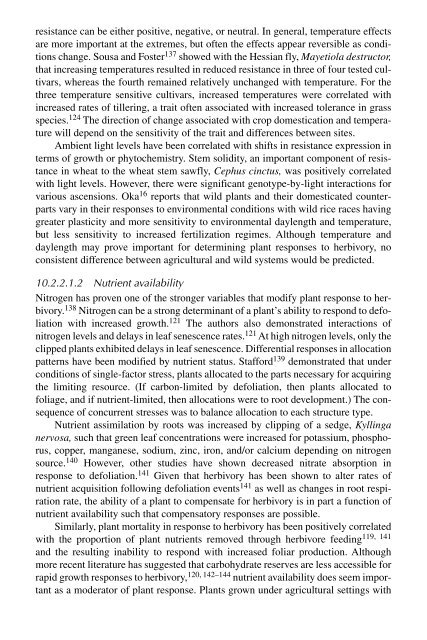Biotic Stress and Yield Loss
Biotic Stress and Yield Loss
Biotic Stress and Yield Loss
- No tags were found...
Create successful ePaper yourself
Turn your PDF publications into a flip-book with our unique Google optimized e-Paper software.
esistance can be either positive, negative, or neutral. In general, temperature effectsare more important at the extremes, but often the effects appear reversible as conditionschange. Sousa <strong>and</strong> Foster 137 showed with the Hessian fly, Mayetiola destructor,that increasing temperatures resulted in reduced resistance in three of four tested cultivars,whereas the fourth remained relatively unchanged with temperature. For thethree temperature sensitive cultivars, increased temperatures were correlated withincreased rates of tillering, a trait often associated with increased tolerance in grassspecies. 124 The direction of change associated with crop domestication <strong>and</strong> temperaturewill depend on the sensitivity of the trait <strong>and</strong> differences between sites.Ambient light levels have been correlated with shifts in resistance expression interms of growth or phytochemistry. Stem solidity, an important component of resistancein wheat to the wheat stem sawfly, Cephus cinctus, was positively correlatedwith light levels. However, there were significant genotype-by-light interactions forvarious ascensions. Oka 16 reports that wild plants <strong>and</strong> their domesticated counterpartsvary in their responses to environmental conditions with wild rice races havinggreater plasticity <strong>and</strong> more sensitivity to environmental daylength <strong>and</strong> temperature,but less sensitivity to increased fertilization regimes. Although temperature <strong>and</strong>daylength may prove important for determining plant responses to herbivory, noconsistent difference between agricultural <strong>and</strong> wild systems would be predicted.10.2.2.1.2 Nutrient availabilityNitrogen has proven one of the stronger variables that modify plant response to herbivory.138 Nitrogen can be a strong determinant of a plant’s ability to respond to defoliationwith increased growth. 121 The authors also demonstrated interactions ofnitrogen levels <strong>and</strong> delays in leaf senescence rates. 121 At high nitrogen levels, only theclipped plants exhibited delays in leaf senescence. Differential responses in allocationpatterns have been modified by nutrient status. Stafford 139 demonstrated that underconditions of single-factor stress, plants allocated to the parts necessary for acquiringthe limiting resource. (If carbon-limited by defoliation, then plants allocated tofoliage, <strong>and</strong> if nutrient-limited, then allocations were to root development.) The consequenceof concurrent stresses was to balance allocation to each structure type.Nutrient assimilation by roots was increased by clipping of a sedge, Kyllinganervosa, such that green leaf concentrations were increased for potassium, phosphorus,copper, manganese, sodium, zinc, iron, <strong>and</strong>/or calcium depending on nitrogensource. 140 However, other studies have shown decreased nitrate absorption inresponse to defoliation. 141 Given that herbivory has been shown to alter rates ofnutrient acquisition following defoliation events 141 as well as changes in root respirationrate, the ability of a plant to compensate for herbivory is in part a function ofnutrient availability such that compensatory responses are possible.Similarly, plant mortality in response to herbivory has been positively correlatedwith the proportion of plant nutrients removed through herbivore feeding119, 141<strong>and</strong> the resulting inability to respond with increased foliar production. Althoughmore recent literature has suggested that carbohydrate reserves are less accessible forrapid growth responses to herbivory, 120, 142–144 nutrient availability does seem importantas a moderator of plant response. Plants grown under agricultural settings with

















